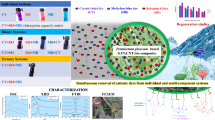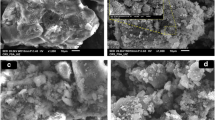Abstract
Date palm ash (DPA) and MgAl-layered double hydroxide (LDH) composites were synthesized by the co-precipitation method and characterized by Fourier transform infrared spectroscopy (FTIR), scanning electron microscope (SEM), X-ray diffraction (XRD), and Brunauer–Emmett–Teller (BET). The DPA-MgAl-LDH (DPA/MgAl) composites were employed for the removal of methyl orange (MO) and eriochrome black-T (EBT) from aqueous phase. Incorporation of 33.33% (w/w) DPA into the layers of MgAl increased the surface area from 44.46 to 140.65 m2/g, which leads to the improved adsorption performance. The maximum adsorption capacity of DPA/MgAl (1:2) at 298 K was 242.98 and 425.16 (mg/g) for MO and EBT, respectively. The adsorption data of dyes were adequately fitted by a pseudo-second-order and Langmuir isotherm model. The composite showed excellent reusability performance up to three cycles. Addition of DPA into MgAl-LDH resulted in an effective low-cost adsorbent for decontamination of dyes from wastewater.

ᅟ









Similar content being viewed by others
References
Abdelouahhab Z, Arias-Jimenez E (1999) Date palm cultivation. Food and agriculture organization (FAO)
Agoudjil B, Benchabane A, Boudenne A, Ibos L, Fois M (2011) Renewable materials to reduce building heat loss: characterization of date palm wood. Energy Buildings 43:491–497
Ahmad M, Ahmad M, Usman AR, Al-Faraj AS, Abduljabbar A, Ok YS, Al-Wabel MI (2017) Date palm waste-derived biochar composites with silica and zeolite: synthesis, characterization and implication for carbon stability and recalcitrant potential. Environ Geochem Health:1–18
Al-Kutti W, Islam AS, Nasir M (2017) Potential use of date palm ash in cement-based materials. J King Saud Univ Eng Sci
Al-Kutti W, Nasir M, Johari MAM, Islam AS, Manda AA, Blaisi NI (2018) An overview and experimental study on hybrid binders containing date palm ash, fly ash, OPC and activator composites. Constr Build Mater 159:567–577
Assirey EAR (2015) Nutritional composition of fruit of 10 date palm (Phoenix dactylifera L.) cultivars grown in Saudi Arabia. J Taibah Univ Sci 9:75–79
Banat F, Al-Asheh S, Al-Makhadmeh L (2003) Evaluation of the use of raw and activated date pits as potential adsorbents for dye containing waters. Process Biochem 39:193–202
Blaisi NI (2018) Environmental assessment of utilizing date palm ash as partial replacement of cement in mortar. J Hazard Mater 357:175–179
Boubakri S, Djebbi MA, Bouaziz Z, Namour P, Jaffrezic-Renault N, Amara ABH, Trabelsi-Ayadi M, Ghorbel-Abid I, Kalfat R (2018) Removal of two anionic reactive textile dyes by adsorption into MgAl-layered double hydroxide in aqueous solutions. Environ Sci Pollut Res:1–16
Chang PR, Zheng P, Liu B, Anderson DP, Yu J, Ma X (2011) Characterization of magnetic soluble starch-functionalized carbon nanotubes and its application for the adsorption of the dyes. J Hazard Mater 186:2144–2150
El Hassani K, Beakou BH, Kalnina D, Oukani E, Anouar A (2017) Effect of morphological properties of layered double hydroxides on adsorption of azo dye Methyl Orange: a comparative study. Appl Clay Sci 140:124–131
Elanchezhiyan SS, Meenakshi S (2017) Synthesis and characterization of chitosan/Mg-Al layered double hydroxide composite for the removal of oil particles from oil-in-water emulsion. Int J Biol Macromol 104:1586–1595
Fiol N, Villaescusa I (2009) Determination of sorbent point zero charge: usefulness in sorption studies. Environ Chem Lett 7:79–84
George G, Saravanakumar MP (2018) Facile synthesis of carbon-coated layered double hydroxide and its comparative characterisation with Zn–Al LDH: application on crystal violet and malachite green dye adsorption—isotherm, kinetics and Box-Behnken design. Environ Sci Pollut Res
Gola D, Malik A, Namburath M, Ahammad SZ (2017) Removal of industrial dyes and heavy metals by Beauveria bassiana: FTIR, SEM, TEM and AFM investigations with Pb (II). Environ Sci Pollut Res:1–11
Gondim DR, Cecilia JA, Santos SO, Rodrigues TNB, Aguiar JE, Vilarrasa-García E, Rodríguez-Castellón E, Azevedo DCS, Silva IJ (2018) Influence of buffer solutions in the adsorption of human serum proteins onto layered double hydroxide. Int J Biol Macromol 106:396–409
Guo L, Zhang X, Chen Q, Ruan C, Leng Y (2016) Enhanced removal performance by the core-shell zeolites/MgFe-layered double hydroxides (LDHs) for municipal wastewater treatment. Environ Sci Pollut Res 23:6749–6757
Ho YS, McKay G (1999) Pseudo-second order model for sorption processes. Process Biochem 34:451–465
Khan SA, Khan SB, Asiri AM (2016) Layered double hydroxide of Cd-Al/C for the mineralization and de-coloration of dyes in solar and visible light exposure. Sci Rep 6:35107
Liu C-H, Wu J-S, Chiu H-C, Suen S-Y, Chu KH (2007) Removal of anionic reactive dyes from water using anion exchange membranes as adsorbers. Water Res 41:1491–1500
Lu Y, Jiang B, Fang L, Ling F, Gao J, Wu F, Zhang X (2016) High performance NiFe layered double hydroxide for methyl orange dye and Cr (VI) adsorption. Chemosphere 152:415–422
Luo S, Wang J (2018) MOF/graphene oxide composite as an efficient adsorbent for the removal of organic dyes from aqueous solution. Environ Sci Pollut Res 25:5521–5528
Mahmoudi K, Hosni K, Hamdi N, Srasra E (2015) Kinetics and equilibrium studies on removal of methylene blue and methyl orange by adsorption onto activated carbon prepared from date pits—a comparative study. Korean J Chem Eng 32:274–283
Moeinpour F, Alimoradi A, Kazemi M (2014) Efficient removal of Eriochrome black-T from aqueous solution using NiFe 2 O 4 magnetic nanoparticles. J Environ Health Sci Eng 12:112
Mohamed SK, Hegazy SH, Abdelwahab NA, Ramadan AM (2017) Coupled adsorption-photocatalytic degradation of crystal violet under sunlight using chemically synthesized grafted sodium alginate/ZnO/graphene oxide composite. Int J Biol Macromol
Morales-Irigoyen EE, de las Mercedes Gómez-y Y, Flores-Moreno JL, Franco-Hernández MO (2017) A bionanohybrid ZnAl-NADS ecological pesticide as a treatment for soft rot disease in potato (Solanum tuberosum L.). Environ Sci Pollut Res:1–10
Mu’azu ND, Jarrah N, Kazeem TS, Zubair M, Al-Harthi M (2018) Bentonite-layered double hydroxide composite for enhanced aqueous adsorption of Eriochrome Black T. Appl Clay Sci 161:23–34
Nguyen TC, Loganathan P, Nguyen TV, Kandasamy J, Naidu R, Vigneswaran S (2017) Adsorptive removal of five heavy metals from water using blast furnace slag and fly ash. Environ Sci Pollut Res
Riaz MA, McKay G, Saleem J (2017) 3D graphene-based nanostructured materials as sorbents for cleaning oil spills and for the removal of dyes and miscellaneous pollutants present in water. Environ Sci Pollut Res 24:27731–27745
Ruan X, Chen Y, Chen H, Qian G, Frost RL (2016) Sorption behavior of methyl orange from aqueous solution on organic matter and reduced graphene oxides modified Ni–Cr layered double hydroxides. Chem Eng J 297:295–303
Savova D, Apak E, Ekinci E, Yardim F, Petrov N, Budinova T, Razvigorova M, Minkova V (2001) Biomass conversion to carbon adsorbents and gas. Biomass Bioenergy 21:133–142
Seco-Reigosa N, Peña-Rodríguez S, Nóvoa-Muñoz JC, Arias-Estévez M, Fernández-Sanjurjo MJ, Álvarez-Rodríguez E, Núñez-Delgado A (2013) Arsenic, chromium and mercury removal using mussel shell ash or a sludge/ashes waste mixture. Environ Sci Pollut Res 20:2670–2678
Seema KM, Mamba BB, Njuguna J, Bakhtizin RZ, Mishra AK (2018) Removal of lead (II) from aqeouos waste using (CD-PCL-TiO2) bio-nanocomposites. Int J Biol Macromol 109:136–142
Shan R-R, Yan L-G, Yang Y-M, Yang K, Yu S-J, Yu H-Q, Zhu B-C, Du B (2015) Highly efficient removal of three red dyes by adsorption onto Mg–Al-layered double hydroxide. J Ind Eng Chem 21:561–568
Song P, Zhang D-Y, Yao X-H, Feng F, Wu G-H (2017) Preparation of a regenerated silk fibroin film and its adsorbability to azo dyes. Int J Biol Macromol 102:1066–1072
Takam B, Acayanka E, Kamgang GY, Pedekwang MT, Laminsi S (2017) Enhancement of sorption capacity of cocoa shell biomass modified with non-thermal plasma for removal of both cationic and anionic dyes from aqueous solution. Environ Sci Pollut Res 24:16958–16970
Vučurović VM, Razmovski RN, Miljić UD, Puškaš VS (2014) Removal of cationic and anionic azo dyes from aqueous solutions by adsorption on maize stem tissue. J Taiwan Inst Chem Eng 45:1700–1708
Xin X, Si W, Yao Z, Feng R, Du B, Yan L, Wei Q (2011) Adsorption of benzoic acid from aqueous solution by three kinds of modified bentonites. J Colloid Interface Sci 359:499–504
Yagub MT, Sen TK, Afroze S, Ang HM (2014) Dye and its removal from aqueous solution by adsorption: a review. Adv Colloid Interf Sci 209:172–184
Yang Z, Ji S, Gao W, Zhang C, Ren L, Tjiu WW, Zhang Z, Pan J, Liu T (2013) Magnetic nanomaterial derived from graphene oxide/layered double hydroxide hybrid for efficient removal of methyl orange from aqueous solution. J Colloid Interface Sci 408:25–32
Yao W, Yu S, Wang J, Zou Y, Lu S, Ai Y, Alharbi NS, Alsaedi A, Hayat T, Wang X (2017) Enhanced removal of methyl orange on calcined glycerol-modified nanocrystallined Mg/Al layered double hydroxides. Chem Eng J 307:476–486
Yasin Y, Abdul Malek AH, Mariam Sumari S (2010) Adsorption of eriochrome black dye from aqueous solution onto anionic layered double hydroxides. Orient J Chem 26:1293
Zhang X, Lei Y, Yuan Y, Gao J, Jiang Y, Xu Z, Zhao S (2018) Enhanced removal performance of Cr (VI) by the core-shell zeolites/layered double hydroxides (LDHs) synthesized from different metal compounds in constructed rapid infiltration systems. Environ Sci Pollut Res:1–12
Zheng X, Li X, Li J, Wang L, Jin W, liu J, Pei Y, Tang K (2018) Efficient removal of anionic dye (Congo red) by dialdehyde microfibrillated cellulose/chitosan composite film with significantly improved stability in dye solution. Int J Biol Macromol 107:283–289
Zubair M, Jose J, Emwas A-H, Al-Harthi MA (2014) Effect of modified graphene and microwave irradiation on the mechanical and thermal properties of poly(styrene-co-methyl methacrylate)/graphene nanocomposites. Surf Interface Anal 46:630–639
Zubair M, Daud M, McKay G, Shehzad F, Al-Harthi MA (2017a) Recent progress in layered double hydroxides (LDH)-containing hybrids as adsorbents for water remediation. Appl Clay Sci 143:279–292
Zubair M, Jarrah N, Manzar MS, Al-Harthi M, Daud M, Mu’azu ND, Haladu SA (2017b) Adsorption of eriochrome black T from aqueous phase on MgAl-, CoAl-and NiFe-calcined layered double hydroxides: kinetic, equilibrium and thermodynamic studies. J Mol Liq 230:344–352
Zubair M, Jarrah N, Ihsanullah KA, Manzar MS, Kazeem TS, Al-Harthi MA (2018) Starch-NiFe-layered double hydroxide composites: efficient removal of methyl orange from aqueous phase. J Mol Liq 249:254–264
Author information
Authors and Affiliations
Corresponding author
Additional information
Responsible editor: Philippe Garrigues
Electronic supplementary material
ESM 1
(DOCX 243 kb)
Rights and permissions
About this article
Cite this article
Blaisi, N.I., Zubair, M., Ihsanullah et al. Date palm ash-MgAl-layered double hydroxide composite: sustainable adsorbent for effective removal of methyl orange and eriochrome black-T from aqueous phase. Environ Sci Pollut Res 25, 34319–34331 (2018). https://doi.org/10.1007/s11356-018-3367-2
Received:
Accepted:
Published:
Issue Date:
DOI: https://doi.org/10.1007/s11356-018-3367-2




